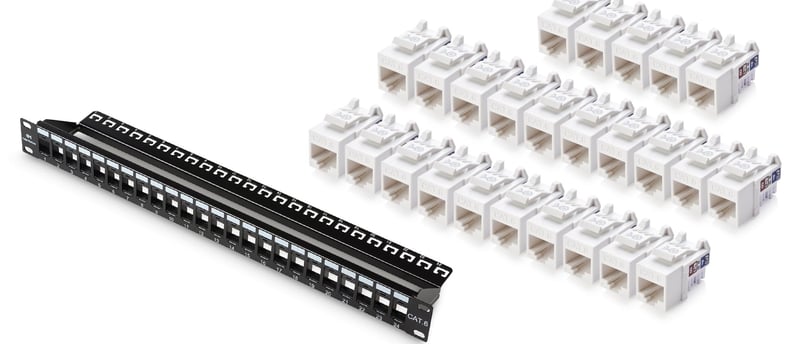Monolithic vs Modular (key stone) patch panels for Cat6
Discover why monolithic patch panels falter with Cat6—lack of flexibility, scalability issues, and maintenance woes make modular designs the smarter choice.
2/26/20253 min read


A patch panel is a device that organizes and connects network cables, simplifying management in data centers or offices. A monolithic patch panel is a single, fixed unit with a set number of ports—unlike modular panels, which allow individual ports to be added or replaced. Cat6, a category of twisted pair cable, supports data rates up to 10 Gbps and has stricter requirements for crosstalk and signal integrity than Cat5e. This analysis explores why monolithic panels' rigid design is less suitable for Cat6's demands, based on industry standards and best practices.
Understanding Monolithic Patch Panels and Cat6
Monolithic Patch Panel: A non-modular, fixed unit with a predetermined number of ports (e.g., 24, 48). Its design requires replacing the entire panel for any changes, limiting adaptability.
Cat6 Cabling: A high-performance Ethernet cable offering greater bandwidth, supporting frequencies up to 250 MHz while reducing interference. It follows TIA-568 standards, which define performance criteria for patch panels—including insertion loss, return loss, and near-end crosstalk (NEXT).
Reasons Why Monolithic Patch Panels Are Not Recommended for Cat6
Several practical and technical factors make monolithic patch panels less than ideal for Cat6, considering flexibility, scalability, maintenance, and performance.
Lack of Flexibility:
In a monolithic patch panel, all ports are permanently integrated. A single port failure or upgrade need requires replacing the entire panel, causing downtime and higher costs.
Contrast with Modular: These panels allow individual module replacement, minimizing disruption. This flexibility is vital for maintaining uptime in Cat6 networks.
Example Scenario: When one port fails in a 48-port monolithic panel, you're left with 47 usable ports and may need a complete replacement. A modular panel lets you simply swap the faulty module.
Scalability Issues:
Expanding a monolithic panel network requires adding entire new panels once ports are exhausted—inefficient in space, cost, and installation. This is especially problematic for Cat6 installations in growing data centers.
Contrast with Modular: These panels allow adding modules within the existing frame, enabling gradual scaling without system overhaul—ideal for dynamic, high-demand networks.
Example Scenario: Needing 50 ports with a 48-port monolithic panel forces installation of a second panel, doubling footprint. A modular panel needs just two additional modules.
Maintenance Challenges:
A single port failure in a monolithic panel can impact the entire unit, requiring complex troubleshooting or repairs. This creates costly downtime in Cat6 high-speed environments.
Contrast with Modular: These designs allow quick replacement of faulty modules, simplifying maintenance and minimizing network disruption.
Example Scenario: Fixing a faulty port might require rewiring or replacing an entire monolithic panel, while a modular panel needs only a simple module swap.
Limited Future-Proofing:
Monolithic panels lock you into Cat6 specifications. Upgrading to Cat6A, Cat7, or fiber optics requires complete panel replacement.
Contrast with Modular: These panels accommodate mixed cable types and standards, allowing infrastructure evolution without total replacement—crucial for long-term Cat6 installations.
Example Scenario: Upgrading to Cat6A for extended 10 Gbps distances means replacing a monolithic panel entirely, while modular panels can integrate Cat6A modules as needed.
Potential Performance Concerns:
While both panel types can meet Cat6 standards (per TIA-568), modular panels typically offer better port isolation and more precise termination options, better maintaining Cat6's performance requirements.
Monolithic panels may provide suboptimal port spacing and shielding, leading to increased near-end crosstalk (NEXT) or alien crosstalk (AXT) in high-density setups, potentially degrading Cat6 performance.
Contrast with Modular: These designs enable better port separation and shielding, meeting Cat6's strict high-speed transmission requirements.
Example Scenario: Dense port placement in monolithic panels may cause signal interference affecting 10 Gbps capability, while modular designs minimize this issue.
Industry Preferences and Best Practices
Industry evidence favors modular patch panels for Cat6 networks. For instance, Structured Cabling Systems emphasizes flexible, scalable infrastructure, aligning with modular designs. A leading networking company's white paper states that "modular patch panels offer greater flexibility and are easier to maintain than their monolithic counterparts."
While TIA-568 doesn't explicitly prohibit monolithic panels for Cat6, it emphasizes performance criteria that modular panels more consistently meet. Patch Panel Basics notes that high-performance applications like Cat6 favor modular panels for their adaptability to new technologies and changing port density needs.
Cost Considerations
Though monolithic panels cost less initially, their long-term expenses mount through maintenance difficulties and full replacement needs. Modular panels, despite higher upfront costs, offer lower total ownership costs through adaptability and simpler repairs—crucial for Cat6 systems where downtime and performance matter most.
Unexpected Detail
An interesting finding is that while both types can meet Cat6 standards technically, monolithic panels' practical limitations—especially in maintaining high-density performance—make them less suitable for dynamic environments. This challenges the assumption that meeting standards alone ensures optimal performance, highlighting the importance of design flexibility for Cat6.
Practical Implications
Using monolithic patch panels with Cat6 can create inefficiencies, particularly in growing networks. For instance, a company using a 48-port monolithic panel faces potential downtime if a port fails, requiring complete replacement, while modular panels allow quick fixes. Given Cat6's role in high-speed, critical environments, monolithic designs' inflexibility and limited scalability make them less advisable.
Southern IT LLC.
We'll Handle I.T.
Support
support@southernitllc.com
210-985-5510
© 2025. All rights reserved.
